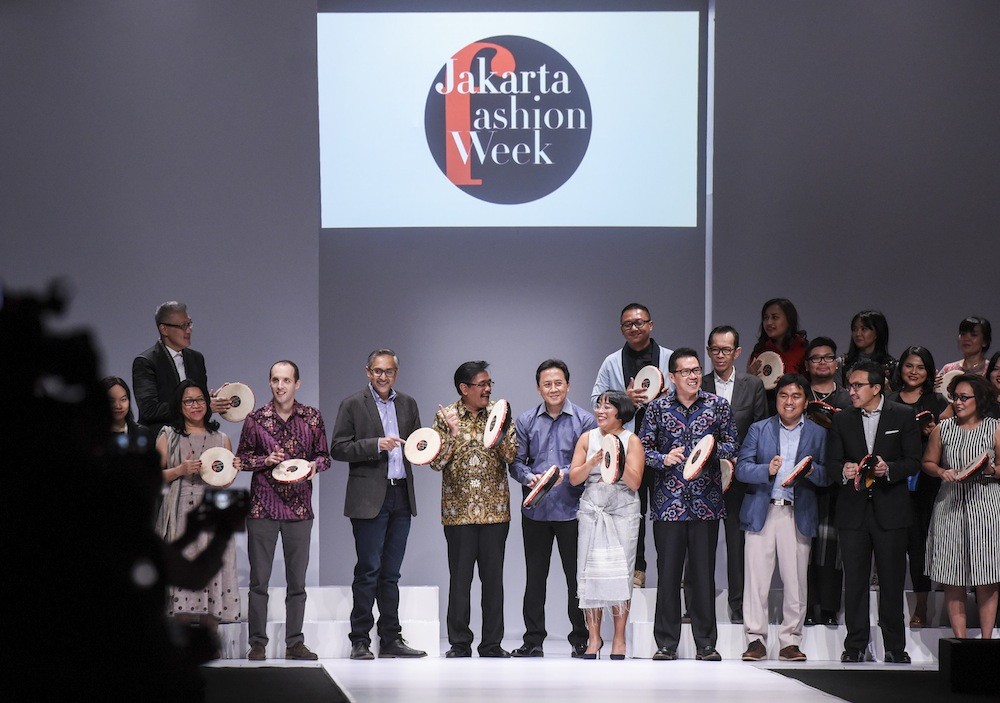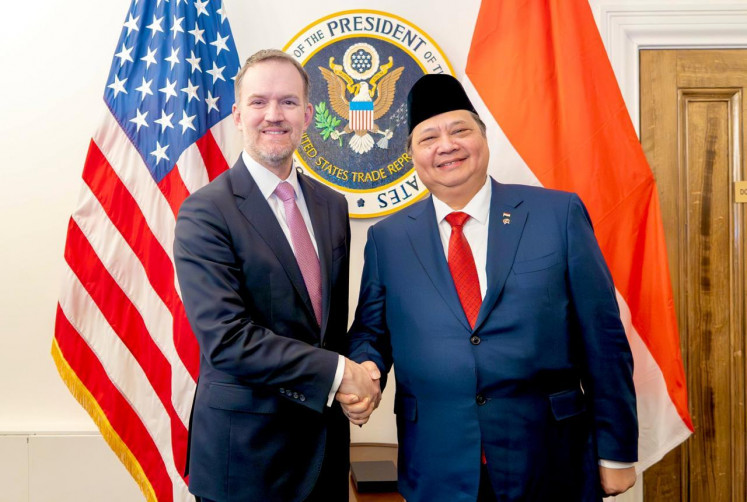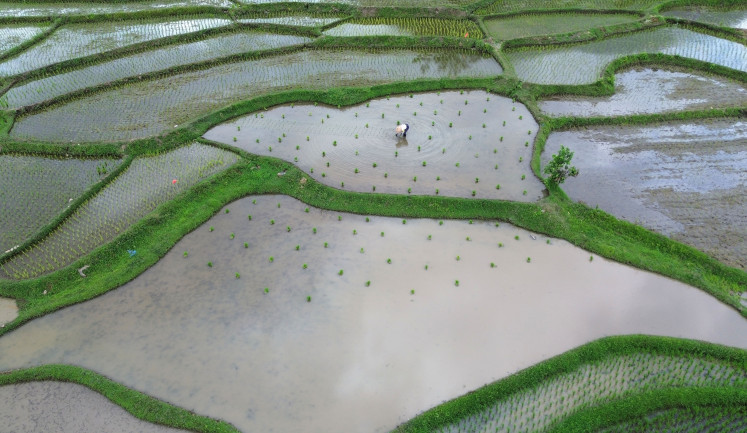Popular Reads
Top Results
Can't find what you're looking for?
View all search resultsPopular Reads
Top Results
Can't find what you're looking for?
View all search resultsCuration is winning formula in fashion
Change text size
Gift Premium Articles
to Anyone
 Jakarta Deputy Governor Djarot Syaiful Hidayat (seventh right), Creative Economy Agency head Triawan Munaf (sixth right) and Jakarta Fashion Week chairwoman Svida Alihsjahbana (fifth right) beat drums to mark the opening of Jakarta Fashion Week 2017 in Senayan City in Jakarta on Saturday. The event will run until Friday. (Antara/Hafidz Mubarak)
Jakarta Deputy Governor Djarot Syaiful Hidayat (seventh right), Creative Economy Agency head Triawan Munaf (sixth right) and Jakarta Fashion Week chairwoman Svida Alihsjahbana (fifth right) beat drums to mark the opening of Jakarta Fashion Week 2017 in Senayan City in Jakarta on Saturday. The event will run until Friday. (Antara/Hafidz Mubarak)
T
he ninth Jakarta Fashion Week (JFW) is about to start. In relation to this, perhaps it is useful for us as its organizers to remind the public that it is more than just a glamorous commercial spectacle consisting of many fashion shows (86 shows in seven days this year, to be exact), creating entertainment for fashion addicts (about 35,000 visitors in one week).
The real purpose of the JFW is to develop and boost the capacity of our designers. This is an industry that serves as a great microcosm of the Indonesian nation. This is the field where our cultural legacy, diversity and our creativity, entrepreneurialism and, crucially, our freedom of expression can take us to a global level.
But something is lacking. Very few of our fashion labels have become sustainable businesses or attain international prestige.
Following the formation of the Tourism and Creative Economy Ministry, the JFW launched an incubation program, Indonesia Fashion Forward (IFF), in 2012. The support for that program from the ministry was crucial and very strong. The Trade Ministry also supported the JFW’s activities to bring foreign buyers into Indonesia for these incubated designers. Under the current administration, the Creative Economy Agency has continued supporting the incubation program.
By 2016, some of our efforts had begun to show some results, even though prior to that we had been steadily reaching some key milestones. Last year, one of the highlights was when a participant of the IFF program, the young hijab designer Dian Pelangi, was selected by The Business of Fashion website as one of the 500 most important fashion people in the world.
This achievement came after Dian’s residence in the London College of Fashion. This in itself was a direct result of cooperation between the JFW and the British Council. Dian has become a powerful symbol of what kind of Muslim country Indonesia is: a place where a young woman can gain international recognition by producing dogma-defying collections.
Earlier this year, several IFF trainees were selected by one of London’s prestigious department stores, Fenwick. Remarkably, these labels were placed in the same area as major fashion brands such as Armani, Joseph and others. President Joko “Jokowi” Widodo and his entourage managed to see first-hand this outstanding achievement. All these labels reported strong commercial results.
Again, the Fenwick success was also a result of a deliberate approach conducted by the JFW and the experts at the Centre for Fashion Enterprise, UK, as well as support from the Indonesian Trade Ministry, which invited Fenwick officials to Indonesia the preceding year.
Another momentous achievement happened later this year. Three IFF labels were selected as finalists for the Asia round of the International Woolmark Prize, arguably the most prestigious fashion competition in the world. It was the first time Indonesia entered the invitation-only competition.
What was even more remarkable was that the label Toton, led by young designer Toton Januar and his business partner Haryo Balitar, ended up winning the Asian round in July 2016, beating contestants from advanced fashion countries such as South Korea and Japan.
The Woolmark Prize was also important because the finalists were eventually exposed to new techniques, suppliers and also fabrics. The competition requires participants to use wool for their collections. In return, Woolmark provides a lot of technical training and information on the wool supply chain to the designers.
This experience created a multiplier effect. Some of the labels opted to develop their own fabric based on wool yarn. This led, in turn, to a situation wherein these labels had to train their manufacturing partners in Indonesia, which included several small hand-loom weavers in Garut, West Java, and a large scale garment manufacturer in Surakarta, Central Java.
New skills and knowledge were created and distributed, even though initially it appeared the process was top-down, focusing only on a highly select numbers of designers. A process of rigorous selection is indeed a prerequisite to groom winners in this highly competitive industry.
The key lies in the curating process. It really depends on the methodology and the credibility of the curators, who must be legitimate, with proven expertise and without conflicts of interest. Also crucial is the international connectivity of the curators and trainers to the crucial international fashion stakeholders (organizers of other fashion weeks, fashion schools, trade shows and international media, among others). These capabilities take years to develop. This is why support from various parts of our government is essential.
In conclusion, the essence of the JFW takes place long before you see those models on the runaway, before the blinding lights and the deafening beat hit your senses. At the same time, we also hope the effect of the JFW will continue long after the tents are brought down, ready to be used again for the same occasion next year.








